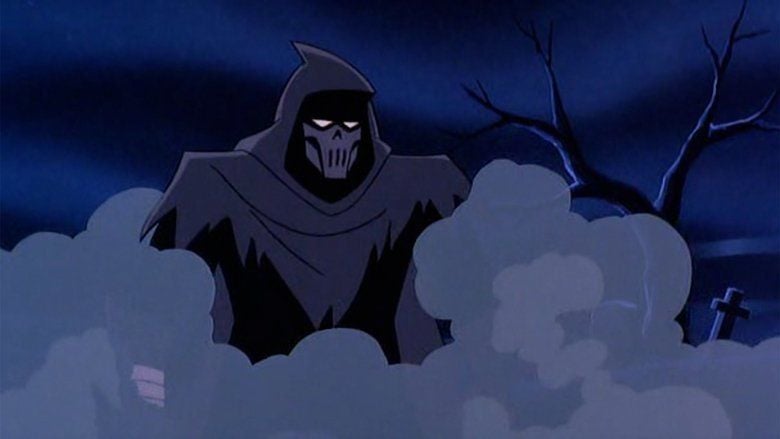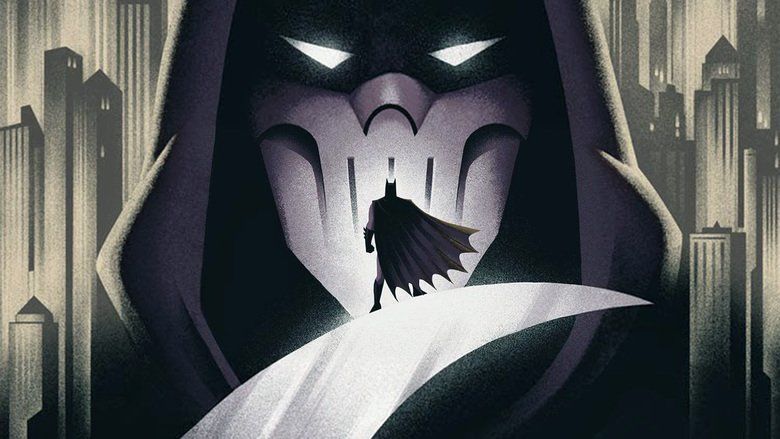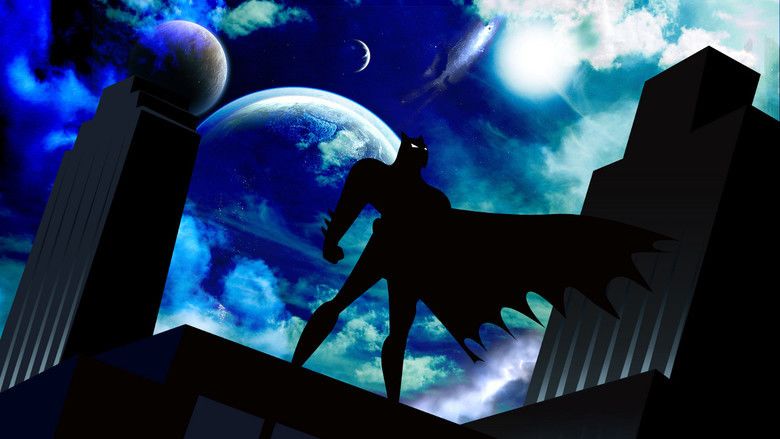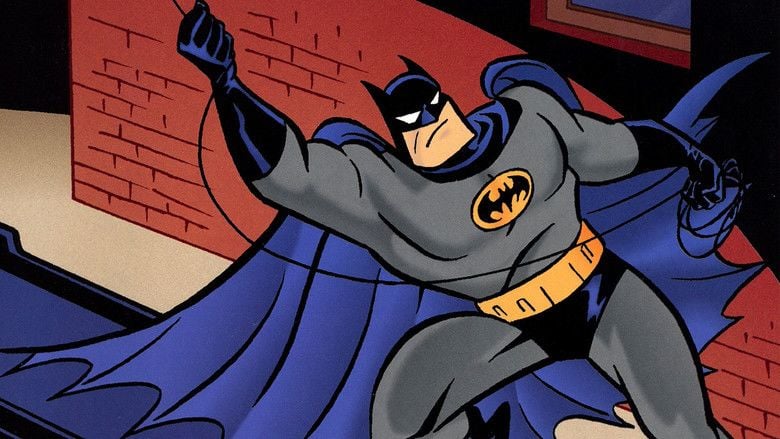Batman: Mask of the Phantasm
8 /10 1 Votes
81% Rotten Tomatoes Genre Animation, Action, Adventure Duration | 7.9/10 IMDb Initial DVD release December 21, 1999 Language English | |||||||||||||||||||||||||||||||||
 | ||||||||||||||||||||||||||||||||||
Release date December 17, 1993 (1993-12-17) Writer Bob Kane (character created by: Batman), Alan Burnett (story), Alan Burnett (screenplay), Paul Dini (screenplay), Martin Pasko (screenplay), Michael Reaves (screenplay) Film series Batman: The Animated Movie Film Series Cast (Batman / Bruce Wayne), (Andrea Beaumont), Efrem Zimbalist, Jr. (Alfred Pennyworth), (The Joker), (City Councilman Arthur Reeves), (Carl Beaumont)Similar movies Justice League: The Flashpoint Paradox , Justice League: The New Frontier , Justice League: Doom , Justice League: Crisis on Two Earths , The Dark Knight , The Dark Knight Rises Tagline The Dark Knight fights to save Gotham city from its deadliest enemy. | ||||||||||||||||||||||||||||||||||
Batman mask of the phantasm 1 10 movie clip your angel of death awaits 1993 hd
Batman: Mask of the Phantasm (also known as Batman: The Animated Movie) is a 1993 American animated neo-noir superhero mystery film featuring the DC Comics character Batman. Directed by Eric Radomski and Bruce Timm, it is a cinematic continuation of Batman: The Animated Series.
Contents
- Batman mask of the phantasm 1 10 movie clip your angel of death awaits 1993 hd
- Batman mask of the phantasm 6 10 movie clip your hands are just as dirty 1993 hd
- Plot
- Cast
- Production
- Themes
- Comic books and merchandise
- Music
- Original release
- Expanded edition release
- Box office
- Critical response
- Legacy
- Home media
- Accolades
- Batman mask of the phantasm 10 10 movie clip goodbye my love 1993 hd
- Patrick explains batman mask of the phantasm and why it s great
- References

The film was written by Alan Burnett, Paul Dini, Martin Pasko and Michael Reaves and stars the vocal talents of Kevin Conroy, Mark Hamill and Efrem Zimbalist, Jr. (all reprising their roles from The Animated Series), in addition to Dana Delany, Hart Bochner, Stacy Keach, and Abe Vigoda. It story follows Batman as he deals with his reconciliation with a former lover, Andrea Beaumont, and pits him against a mysterious vigilante who is murdering Gotham City's crime bosses. The film's plotline was inspired by Mike W. Barr's Batman: Year Two comic book story arc, but features an original antagonist, the titular Phantasm, in place of The Reaper.

Originally planned for a direct-to-video release, Warner Bros. ultimately decided to give Mask of the Phantasm a theatrical release, condensing its production into a strenuous eight-month schedule. The film was released through the studio's Family Entertainment division on December 25, 1993 to widespread acclaim from critics, who praised the animation, voice performances, storyline and music. However, due to the decision to release it in theaters on short notice, Mask of the Phantasm failed at the box office.

After its release on home video, the film developed a cult following. Its eventual success led to two direct-to-video standalone sequels, Batman & Mr. Freeze: SubZero in 1997 and Mystery of the Batwoman in 2003. Until the limited release of Batman: The Killing Joke in 2016, Mask of the Phantasm was the only animated Batman film to be given a theatrical release. In recent years, many publications, including Time, IGN and WhatCulture, have ranked it among the best Batman films ever made and among the best animated films ever made.

Batman mask of the phantasm 6 10 movie clip your hands are just as dirty 1993 hd
Plot

The film is presented in a nonlinear narrative, jumping between the present and flashbacks to the past. This is a linear summary of the plot.

A young Bruce Wayne meets Andrea Beaumont while visiting his parents' grave, and the pair form a deep mutual attraction. That night, in one of his first crime-fighting attempts, Bruce foils an armored car robbery. Although he succeeds, he is discouraged because the criminals did not fear him. Eventually, Bruce decides to abandon his plans to become a vigilante and proposes marriage to Andrea. However, Andrea mysteriously leaves Gotham with her father, businessman Carl Beaumont, ending her engagement in a "Dear John" letter. Believing he has lost his last chance of having a normal life, Bruce becomes Batman.

Ten years later, Batman confronts a group of Gotham City crime bosses led by Chuckie Sol, who are intending to launder millions of counterfeit dollars in a casino. As Sol escapes to his car, a cloaked figure attacks him; Sol is killed when the figure causes him to drive out the side of a parking garage and into a neighboring building. Batman arrives soon after, and bystanders blame him for Sol's death. Councilman Arthur Reeves tells the media that Batman is a menace (despite Commissioner Gordon's protests), then attends a party at Wayne Manor, hosted by Bruce Wayne. Reeves teases Bruce for allowing Andrea to leave him.

The cloaked figure murders another gangster, Buzz Bronski, in the same cemetery Bruce met Andrea. Batman investigates Bronski's death and wanders to his parents' tombstone. He overhears Andrea talking at her mother's grave, just as she had been when he first met her. She is startled by Batman's appearance and he flees. Batman finds evidence linking Carl Beaumont with Sol, Bronski and a third gangster: Salvatore Valestra. He breaks into Valestra's home and discovers a photograph of Bronski, Valestra, Sol and Beaumont seated at a table. When he visits Andrea to try to get more answers she rebuffs him, intimating that she knows his identity. Meanwhile, Valestra believes Batman killed the others and will come for him, so he turns to the Joker for help.
The figure arrives at Valestra's house but finds the gangster dead by Joker's hands. Joker has strapped a camera to Valestra's corpse and sees the murderer is not Batman. The figure escapes as the house explodes. Batman pursues but is interrupted by the police. Andrea appears and saves Bruce. Andrea later explains that she and her father had been hiding in Europe from Valestra's mob, from whom he had embezzled money. Her father repaid but they put out a hit on him. Bruce now believes her father is the killer. Bruce ponders resuming his relationship with Andrea and giving up Batman. He notices a familiar-looking man in the background of the photo of Bronski, Valestra, Sol and Beaumont: the man who would become the Joker. Joker visits Reeves and presses him for information; Reeves insists that Batman is the cloaked killer. He professes his ignorance but Joker believes Reeves needs to protect his reputation and poisons him. Reeves is taken to the hospital where Batman later breaks in and interrogates him. Reeves confesses he helped the Beaumonts escape and told Valestra's mob their location.
The cloaked figure tracks Joker to his hideout and reveals itself as Andrea, intent on avenging her father's death by killing every last surviving member of Valestra's mob. With the others dead Joker is the last one alive, and is the one who carried out the hit on her father. Having already deduced her identity, Joker fights her. Just before he can kill Andrea, Batman arrives and begs Andrea to give up her quest. She refuses and disappears. Batman and the Joker battle to a stalemate. Moments later Andrea returns and seizes Joker, bidding Batman goodbye before vanishing with the maniacally laughing clown. The amusement park erupts in a series of explosions and Batman barely escapes. Alfred later consoles Bruce, telling him that no one could have helped Andrea. Bruce finds her locket, containing a picture of himself and Andrea, in the Batcave. Meanwhile, Andrea departs from Gotham alone on an ocean liner. Batman stands on top of a Gotham building when the Bat-Signal appears in the sky, and swings off into the night to continue his war on crime.
Cast
Additional voices include Jeff Bennett, Ed Gilbert, Marilu Henner, Pat Musick, Thom Pinto, Neil Ross, and Vernee Watson-Johnson.
Production
Impressed by the success of the first season of Batman: The Animated Series on Fox, Warner Bros. assigned Alan Burnett to write a story for a full-length animated film. The original idea for the film was to have Batman being captured by his enemies at Arkham Asylum and be put on a trila by them, as they wanted to show that he was guilty of make them what had them became. The idea's concept, however, was considered "too brainy", as it required Batman to be inmobile during a long time, so the idea was later used in the series' episode "Trial", which was aired after the movie's release. Although the Joker does play a pivotal role in the film, it was Burnett's intention to tell a story far removed from the television show's regular rogues gallery. Burnett also cited he "wanted to do a love story with Bruce because no one had really done it on the TV show. I wanted a story that got into his head." In reality, the creative team had said that they originally didn't want to use the Joker in the film. Conversely, Paul Dini stated that the Joker was always part of the film from the beginning of its production. The writers were highly cautious of placing the Joker in the film as they did not want any connection to Tim Burton's 1989 film Batman, but writer Michael Reaves said, "We then realized that we could make his appearance serve the story in a way that we never could in live-action." In order to keep the Joker as a solo threat, Bruce Timm and Burnett convinced frequent Animated Series writer Paul Dini to not use Harley Quinn in the film for that reason. The same technique was previously used in the episodes "Joker's Wild" and "The Strange Secret of Bruce Wayne".
Aiding Burnett in writing the script were Martin Pasko, who handled most of the flashback segments; Reaves, who wrote the climax; and Dini, who claims he "filled in holes here and there". The film's plot was heavily influenced by the 1987 miniseries Batman: Year Two, written by Mike W. Barr and illustrated by Alan Davis, Paul Neary, Alfredo Alcala, Mark Farmer and Todd McFarlane. Orson Welles' 1941 classic Citizen Kane served as an influence for the flashbacks, a story about loss and the passage of time. The character of Hazel, the cook robot of the World of the Future Fair, was named by Burnett after Hazel the Maid (portrayed by actress Shirley Booth), The Saturday Evening Post protagonist of cartoonist Ted Key's TV show Hazel. On the other hand, the design of the Phantasm went into 20 different versions until it was found one which convinced the film's crew. According to Burnett, the Phantasm was like the Grim Reaper with a cape, although his idea was to resemble him to the Ghost of Christmas Future of Charles Dickens' novel A Christmas Carol, something that even the Joker mentions in the finished version of the film.
Early in production, Warner Bros. decided to release Phantasm as a theatrical release, rather than straight to video. That left less than a year for production time (most animated features take well over two years from finished story to final release). Due to this decision, the animators went over the scenes in order to accommodate the widescreen theatrical aspect ratio. The studio cooperated well, granting the filmmakers a large amount of creative control.
Warner Bros. also increased the production budget to $6 million, which gave the filmmakers opportunities for more elaborate set pieces. The opening title sequence featured a flight through an entirely computer-generated Gotham City. As a visual joke, sequence director Kevin Altieri set the climax of the film inside a miniature automated model of Gotham City, where Batman and the Joker were giants. This was an homage to a mainstay of Batman comic books of the Dick Sprang era, often featuring the hero fighting against a backdrop of gigantic props (they would later do another homage to Sprang's works in The New Batman Adventures episode "Legends of the Dark Knight"). From start to finish, the film was completed within eight months.
Themes
Paul Dini intended each of the flashbacks into Batman's love life to "have a tendency to get worse, when you hope things will get better." Bruce's relationship with Andrea, which at first shows promise, eventually turns into turmoil. At first, Bruce and Andrea are set for marriage, but then Bruce is given a farewell note from Andrea cutting off their relationship. This eventually leads into Bruce's decision to become Batman. Richard Corliss of Time felt this scene paralleled Andrea's decision to avenge her own parents and reject love, when she finds her own father murdered. Both events transform the two people (Bruce becomes Batman, Andrea becomes the Phantasm). One scene depicts Bruce Wayne at his parents' tombstone saying "I didn't count on being happy." According to Reaves, this scene was to be a pivotal moment in Bruce's tragic life, as he denies himself the opportunity to live a normal life. Reaves also stated: "When Bruce puts on the mask for the first time, [after Andrea breaks their engagement], and Alfred says 'My God!' he's reacting in horror, because he's watching this man he's helped raise from childhood, this man who has let the desire for vengeance and retribution consume his life, at last embrace the unspeakable."
Comic books and merchandise
In December 1993, two novelizations were released. One was written by Burnett, Dini, and Andrew Helfer with the other authored by Geary Gravel.
DC Comics released a comic book adaptation written by Kelley Puckett and drawn by Mike Parobeck. The comic book adaptation was later included with the VHS release. Kenner, who had already released toys for the cartoon series, produced several tie in figures for the film, including Joker and the Phantasm (packaged unmasked, spoiling a pivotal plot point in the film). Batman & Robin Adventures Annual #1: Shadow of the Phantasm was a comic book sequel to the film. It was written by Dini and released in 1996. In 2015, a DC Collectibles action figure 2-pack featuring Batman and Phantasm was released.
Music
The soundtrack was composed by Shirley Walker, the main composer for The Animated Series. Walker cited the score as a favorite among her own compositions. In an interview with Cinemusic.com, Walker explained that the "latin" lyrics used in the Main Title were actually names of key Warner Bros. staff read backwards. The song "I Never Even Told You" was written by Siedah Garrett and Glen Ballard.
The score was originally released on December 14, 1993 by Reprise Records. On March 24, 2009, La-La Land Records released a limited expanded edition. The release includes all tracks found on the original release with some tracks expanded. It also features almost 30 minutes of previously unreleased material.
Original release
All music composed by Walker except where otherwise noted.
Expanded edition release
Previously unreleased tracks are in bold.
- "Main Title: Batman: Mask of the Phantasm" (Expanded) (5:01)
- "The Promise" (Expanded) (1:25)
- "Ski Mask Vigilante" (Expanded) (4:28)
- "Fancy Footwork" (0:40)
- "Phantasm's Graveyard Murder" (3:52)
- "Bad News/Set Trap/May They Rest in Peace" (1:51)
- "First Love" (1:59)
- "City Street Drive/Sal Velestra/Good Samaritan" (2:16)
- "Birth of Batman" (Expanded) (6:01)
- "The Joker's Big Entrance" (3:02)
- "The Big Chase" (5:40)
- "Nowhere to Run" (2:01)
- "A Plea for Help" (1:01)
- "A Tall Man/Arturo and his Pal/Makes You Want to Laugh/What's So Funny?" (4:04)
- "Andrea Remembers/True Identity" (3:18)
- "Phantasm and Joker Fight" (6:01)
- "Batman's Destiny" (1:46)
- "I Never Even Told You" (4:23)
- "Theme from Batman: Mask of the Phantasm" (2:06) (Bonus Track)
- "Welcome to the Future!" (1:01) (Bonus Track)
Box office
Batman: Mask of the Phantasm opened on December 25, 1993 in the United States in 1,506 theaters, accumulating $1,189,975 over its first 2 days. The film went on to gross $5,617,391 in the domestic total box office intake. The filmmakers blamed Warner Bros. for the unsuccessful marketing campaign. Mask of the Phantasm eventually turned a profit with its various home video releases.
Critical response
Batman: Mask of the Phantasm received generally positive reviews from critics. The film has an 82% overall approval rating on Rotten Tomatoes with the consensus stating, "Stylish and admirably respectful of the source material, Batman: Mask of the Phantasm succeeds where many of the live-action Batman adaptations have failed." Empire cited it as the best animated film of 1993, and felt it contained better storylines than Tim Burton's Batman and Batman Returns. TV Guide was impressed with the art deco noir design that was presented. In addition the film's climax and Batman's escape from the Gotham City Police Department were considered to be elaborate action sequences. Richard Harrington of The Washington Post agreed with overall aspects that included the animation, design, dialogue and storyline, as well as Shirley Walker's film score. Gene Siskel and Roger Ebert regretted not having viewed the film during its theatrical release and gave the film a positive review, with Siskel feeling that Phantasm was better than Batman Returns and Joel Schumacher's Batman Forever, and only slightly below Batman. Siskel's only quibble was Hamill as The Joker.
However, Stephen Holden of The New York Times thought the voice performances were "flat and one-dimensional". Chris Hicks of the Deseret News felt "the picture didn't come alive until the third act" feeling that the animators sacrificed the visuals for the storyline. In addition, he felt Mark Hamill "stole the show." Leonard Klady of Variety had mixed reactions towards the film, but his review was negative overall. He felt the overall themes and morals were clichéd and cited the animation to be to the "point of self-parody".
Legacy
Over time, the film has become a beloved cult hit. In a 2010 list, IGN ranked Mask of the Phantasm as the 25th best animated film of all time. That same year IGN also stated it was "the Dark Knight's best big screen story" until Batman Begins. In 2011, Total Film also named Mask of the Phantasm as one of the greatest animated movies of all time, coming in at 47th out of 50. Time ranked Phantasm as one of the 10 best superhero films ever in 2011. Wired's Scott Thill called Kevin Conroy "the finest Batman on record" in 2009. In October 2012, WhatCulture also praised the film, saying it was at the same level as Christopher Nolan's The Dark Knight Trilogy, if not slightly higher. In 2016, the popular Internet reviewer Nostalgia Critic described Mask of the Phantasm as the best cinematic representation of the Batman character, as well as an underrated film deserving of a Blu-ray release.
Home media
Mask of the Phantasm was released on LaserDisc in April 1994 and on VHS in May of the same year. The VHS was reissued in April 2003 as part of a three-tape pack with Batman & Mr. Freeze: SubZero and Batman Beyond: Return of the Joker. Mask of the Phantasm was first released on DVD in December 1999 as a snap case and in October 2005 as a keep case with the insert. The film was re-released in April 2004 as a three disc DVD box set that included SubZero and Return of the Joker. That version is currently out of print. Warner Home Video re-released the film again in February 2008 as a double feature DVD with SubZero. The film was released as part of the Warner Archive Collection on Blu-ray on July 25, 2017, featuring new high definition transfers of 16:9 and 4:3 presentations of the film.
Accolades
Alongside The Lion King and The Nightmare Before Christmas, Mask of the Phantasm was nominated for an Annie Award in the category of Best Animated Feature, but lost to The Lion King.
Batman mask of the phantasm 10 10 movie clip goodbye my love 1993 hd
Patrick explains batman mask of the phantasm and why it s great
References
Batman: Mask of the Phantasm WikipediaBatman: Mask of the Phantasm IMDbBatman: Mask of the Phantasm Rotten TomatoesBatman: Mask of the Phantasm themoviedb.org
